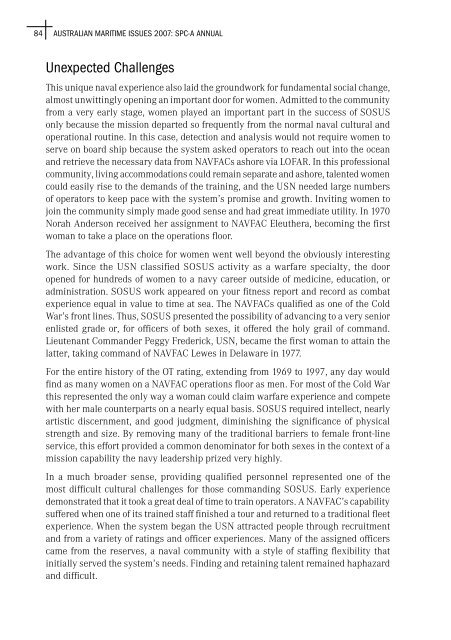Australian Maritime Issues 2007 - Royal Australian Navy
Australian Maritime Issues 2007 - Royal Australian Navy
Australian Maritime Issues 2007 - Royal Australian Navy
You also want an ePaper? Increase the reach of your titles
YUMPU automatically turns print PDFs into web optimized ePapers that Google loves.
84 AUSTRALIAN MARITIME ISSUES <strong>2007</strong>: SPC-A ANNUAL<br />
Unexpected Challenges<br />
This unique naval experience also laid the groundwork for fundamental social change,<br />
almost unwittingly opening an important door for women. Admitted to the community<br />
from a very early stage, women played an important part in the success of SOSUS<br />
only because the mission departed so frequently from the normal naval cultural and<br />
operational routine. In this case, detection and analysis would not require women to<br />
serve on board ship because the system asked operators to reach out into the ocean<br />
and retrieve the necessary data from NAVFACs ashore via LOFAR. In this professional<br />
community, living accommodations could remain separate and ashore, talented women<br />
could easily rise to the demands of the training, and the USN needed large numbers<br />
of operators to keep pace with the system’s promise and growth. Inviting women to<br />
join the community simply made good sense and had great immediate utility. In 1970<br />
Norah Anderson received her assignment to NAVFAC Eleuthera, becoming the first<br />
woman to take a place on the operations floor.<br />
The advantage of this choice for women went well beyond the obviously interesting<br />
work. Since the USN classified SOSUS activity as a warfare specialty, the door<br />
opened for hundreds of women to a navy career outside of medicine, education, or<br />
administration. SOSUS work appeared on your fitness report and record as combat<br />
experience equal in value to time at sea. The NAVFACs qualified as one of the Cold<br />
War’s front lines. Thus, SOSUS presented the possibility of advancing to a very senior<br />
enlisted grade or, for officers of both sexes, it offered the holy grail of command.<br />
Lieutenant Commander Peggy Frederick, USN, became the first woman to attain the<br />
latter, taking command of NAVFAC Lewes in Delaware in 1977.<br />
For the entire history of the OT rating, extending from 1969 to 1997, any day would<br />
find as many women on a NAVFAC operations floor as men. For most of the Cold War<br />
this represented the only way a woman could claim warfare experience and compete<br />
with her male counterparts on a nearly equal basis. SOSUS required intellect, nearly<br />
artistic discernment, and good judgment, diminishing the significance of physical<br />
strength and size. By removing many of the traditional barriers to female front-line<br />
service, this effort provided a common denominator for both sexes in the context of a<br />
mission capability the navy leadership prized very highly.<br />
In a much broader sense, providing qualified personnel represented one of the<br />
most difficult cultural challenges for those commanding SOSUS. Early experience<br />
demonstrated that it took a great deal of time to train operators. A NAVFAC’s capability<br />
suffered when one of its trained staff finished a tour and returned to a traditional fleet<br />
experience. When the system began the USN attracted people through recruitment<br />
and from a variety of ratings and officer experiences. Many of the assigned officers<br />
came from the reserves, a naval community with a style of staffing flexibility that<br />
initially served the system’s needs. Finding and retaining talent remained haphazard<br />
and difficult.
















